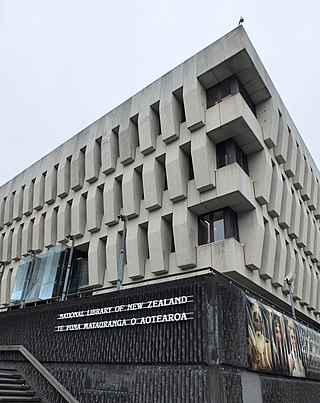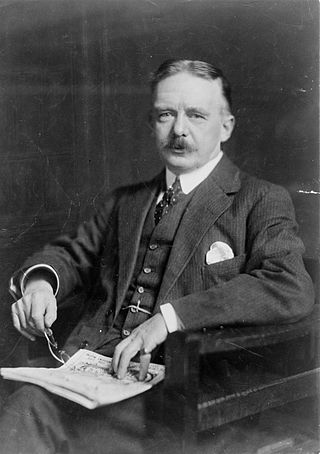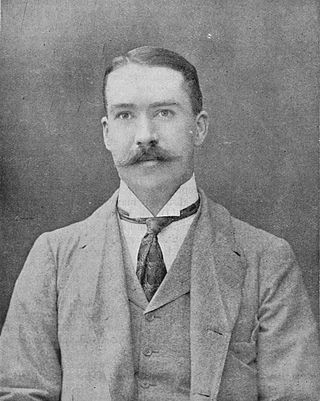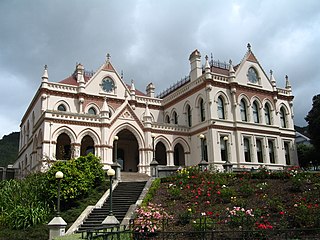
The National Library of New Zealand is charged with the obligation to "enrich the cultural and economic life of New Zealand and its interchanges with other nations". Under the Act, the library's duties include collecting, preserving and protecting New Zealand's documentary heritage, supporting other libraries in New Zealand, and collaborating with peer institutions abroad. The library headquarters is on the corner of Aitken and Molesworth Streets in Wellington, close to the New Zealand Parliament Buildings and the Court of Appeal.

Thorndon is a historic inner suburb of Wellington, the capital city of New Zealand. Because the suburb is relatively level compared to the hilly terrain elsewhere in Wellington it contained Wellington's elite residential area until it changed in the 1960s with the building of a new motorway and the erection of tall office buildings on the sites of its Molesworth Street retail and service businesses.

The Beehive is the common name for the Executive Wing of New Zealand Parliament Buildings, located at the corner of Molesworth Street and Lambton Quay, Wellington. It is so-called because its shape is reminiscent of that of a traditional woven form of beehive known as a skep. It is registered as a Category I heritage building by Heritage New Zealand.

New Zealand Parliament Buildings house the New Zealand Parliament and are on a 45,000 square metre site at the northern end of Lambton Quay, Wellington. From north to south, they are the Parliamentary Library building (1899); the Edwardian neoclassical-style Parliament House (1922); the executive wing, called "The Beehive" (1977); and Bowen House. Currently, an additional building for housing Members of Parliament is under construction, which is expected to be completed in 2026. Whilst most of the individual buildings are outstanding for different reasons, the overall setting that has been achieved "has little aesthetic or architectural coherence".

Guy Ngan was a New Zealand artist. He worked across a large range of media, including sculpture, painting, drawing, design and architecture, and is known for his incorporation of Māori motifs such as the tiki. Many of his works are in prominent places, such as the tapestry in the Beehive and sculpture at the Reserve Bank, while many others are dotted around the country in smaller towns and suburban locations such as Stokes Valley.

The New Zealand Electronic Text Collection is a freely accessible online archive of New Zealand and Pacific Islands texts and heritage materials that are held by the Victoria University of Wellington Library. It was named the New Zealand Electronic Text Centre until October 2012.
James Albert Beard was a New Zealand architect, town planner, and landscape architect.

Charles Wilson was a New Zealand politician of the Liberal Party. He was the first chief librarian of the General Assembly Library.

Antrim House is a historic Italianate house located in Wellington, New Zealand registered as a category 1 building by Heritage New Zealand. Antrim House was built as the home for Robert Hannah and his family.

New Zealand's Old Government Buildings sit on the Government Buildings Historic Reserve, on Lambton Quay in central Wellington. The buildings were completed in 1876 on land reclaimed from Wellington Harbour to house the young New Zealand Government and its public service.

The Hunter Building is the original building of Victoria University of Wellington's Kelburn campus in Wellington, New Zealand. It is a major landmark in the Wellington region and closely associated and considered a symbol of the university. The distinct architecture of the building is a notable example of Edwardian Gothic-revival, with red brick and Oamaru stone façade, along with grand internal entrances, staircases and original university library. The building is a noteworthy example of work from the Wellington architectural practice of Penty & Blake. While opened on 30 March 1906, the building was not completed to its original design, but was progressively added to as the college grew. The building is named after Sir Thomas Alexander Hunter, a well regarded professor of mental science and political economy. Following the end of the Great War, northern and southern wings were added to the building, providing new teaching areas, recreational spaces and a new library.

Alexander Horsburgh Turnbull was a New Zealand merchant, dandy and book collector. On his death, his collection became the nucleus of the Alexander Turnbull Collection, initially housed in his residence, Turnbull House, but as of 1987 housed with the collections of the National Library of New Zealand, a body formed in 1965 by the amalgamation of three libraries, including the one bearing Turnbull's name. In 1913 Turnbull anonymously donated his Māori and Pacific artefacts to the Dominion Museum.

The New Zealand Parliamentary Library, known until 1985 as the General Assembly Library, is the library and information resource of the New Zealand Parliament. The present building that houses the library was completed in 1899; it survived a fire that destroyed the rest of the General Assembly building in 1907.
Francis Gordon Wilson was an Australian-born New Zealand architect. Wilson oversaw the design of New Zealand’s state housing programme from the 1930s onwards. He was the New Zealand Government Architect at the time of his death.

Thomas Turnbull (1824–1907) was a notable New Zealand architect.

Parliament House, in Lambton Quay, Wellington, is the main building of the New Zealand Parliament Buildings. It contains the Parliament's debating chamber, speaker's office, visitors' centre, and committee rooms. It was built between 1914 and 1922, replacing an earlier building that burned down in 1907. Parliament started using the yet to be completed building from 1918. Parliament House was extensively earthquake strengthened and refurbished between 1991 and 1995. It is open for visitors almost every day of the year, and is one of Wellington's major visitor attractions. Parliament House is a Category 1 historic building registered by Heritage New Zealand.

Bolton Street Memorial Park, formerly known as Bolton Street Cemetery, is the oldest cemetery in Wellington, New Zealand. Dating back to 1840, many notable people are buried here. Situated in the suburb of Thorndon, the Wellington City Council's memorial trail number five covers the Bolton Street Memorial Park and visits notable graves, points of interest, lookouts and buildings.

William Turnbull was an architect based in Wellington, New Zealand. He was the fourth and youngest son of architect Thomas Turnbull. He joined his father's practice in 1882 and became a partner in 1891. He was born in San Francisco where his father was working at the time. He moved to New Zealand with his family in 1871. In his younger years, he played rugby union at Poneke Football Club in Kilbirnie.
James Edward Traue was a New Zealand librarian. He was chief librarian of the Alexander Turnbull Library from 1973 to 1990.

Fergus George Frederick Sheppard was a New Zealand architect, who served as the chief government architect from 1959 until his retirement in 1971. During his time in this capacity he was involved with the design of the Beehive, among hundreds of other public buildings.


















